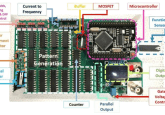Graphene-based biosensors: a new hope in drug development and diagnostics?

12 June, 2014
A research group working in an interdisciplinary project combining computational chemistry with nanoscience has created a new artificial chemical sensor based on the pain receptor μ-opioid receptor.
Researchers have developed an electronic biosensor for opioids, which contains a modified version of the μ-opioid receptor protein chemically attached to a graphene field-effect transistor to read out ligand binding. The engineered receptor is a computationally redesigned version of the protein with increased solubility and stability, which is much easier to produce in bacteria. The device demonstrated high sensitivity and selectivity for the opioid receptor antagonist naltrexone, with a detection limit of 10 pg/mL.
“Many novel opioids have been developed over the centuries,” commented Renyu Liu, (University of Pennsylvania, PA, USA) one of the senior authors of the study. “However, none of them has achieved potent analgesic effects without notorious side effects, including devastating addiction and respiratory depression. This novel tool could potentially aid the development of new opioids that minimize these side effects.”
“Due to the challenges associated with isolating these receptors from their membrane environment without losing functionality,” Liu continued. “The traditional methods of studying them involved indirectly investigating the interactions between opioid and the receptor via radioactive or fluorescent labeled ligands, for example. This multi-disciplinary effort overcame those difficulties, enabling us to investigate these interactions directly in a cell-free system without the need to label any ligands.”
The manufacturing process indicated high reliability and the technology could be potentially applied to a number of chemical sensor proteins to produce devices potentially useful in drug development and clinical diagnostics.
Sources: Lerner MB, Matsunaga F, Han GH et al. Scalable production of highly sensitive nanosensors based on graphene functionalized with a designed G protein-coupled receptor. Nano. Letters DOI: 10.1021/nl5006349 (2014) (Epub ahead of print); Penn research combines graphene and painkiller receptor.





